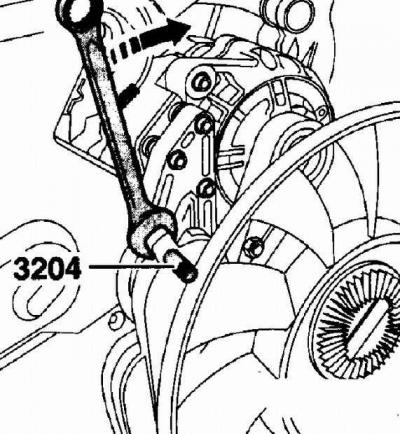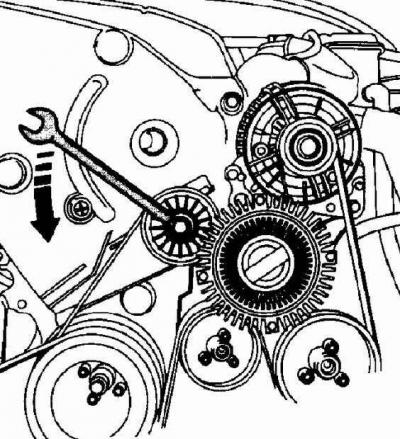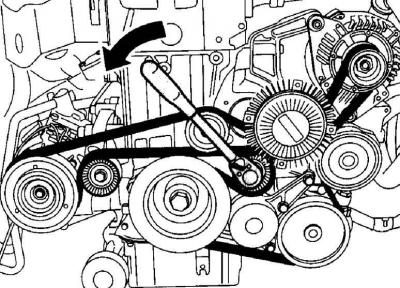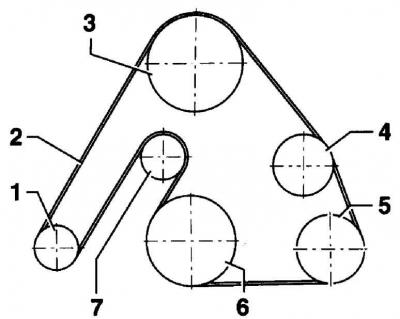Location of belts on four-cylinder gasoline engines

- 1 - belt tensioner,
- 2 - generator,
- 3 - fan,
- 4 - water pump,
- 5 - power steering pump,
- 6 - water pump belt,
- 7 - fan and generator power steering belt,
- 8 - vibration damper,
- 9 - air conditioning compressor belt tensioner,
- 10 - air conditioning compressor belt,
- 11 - air conditioning compressor
A V-ribbed belt is essentially a flat belt with ribs on one side. The V-ribbed belt drives the generator, power steering pump, radiator fan, air conditioning compressor and water pump, depending on the engine modification. On models with four-cylinder engines with an air conditioning system, a separate belt is used to drive the air conditioning compressor.
A/C compressor belt on four-cylinder engines with air conditioning
Removing
1. Remove the V-ribbed belts for the power steering pump drive, alternator and radiator fan.
2. If the belt will be reinstalled using a marker or paint, mark the direction of rotation with an arrow.

3. Loosen the screws securing the poly V-belt tensioning mechanism and after loosening the tension of the V-ribbed belt, remove it from the pulleys.
Installation
1. Install the V-ribbed belt on the pulleys. When reinstalling the V-ribbed belt, install it in accordance with the previously marked arrow.
2. Check that the V-ribbed belt is correctly positioned on the pulleys.

3. Install the torque wrench on the poly V-belt tensioning roller bracket and turn it to 25 Nm and in this position tighten the tensioner fixing bolts (A).
4. Install the alternator power steering pump drive belt and radiator fan.
Power steering pump, alternator and radiator fan drive belt on four-cylinder gasoline engines
Removing
1. If the belt is to be reinstalled, use a marker or paint to mark the direction of rotation of the belt.
2. Move the belt cover forward.

3. To loosen the belt tension, use a wrench to turn the tensioner clockwise and fix it with a steel rod with a diameter of 5 mm.
4. Remove the belt from the pulleys.
Installation
1. Check that all pulleys are securely fastened, otherwise tighten the pulley mounting bolts.
2. Install the belts on the engine pulleys. When reinstalling the belts, install them in accordance with the previously marked arrows.

3. Using a wrench, push the belt tensioner in a clockwise direction and remove the steel rod that secures the tensioner. Slowly release the belt tensioner and the belt will automatically tension.
4. Install the belt cover.
5. Start the engine and check the operation of the belts.
Power Steering Pump Drive Belt Water Pump Alternator and Radiator Fan on Diesel Engines
Removing
Warning: The removal and installation of the belt is similar to the removal and installation of the belt for a four-cylinder gasoline engine. This subsection contains only operations specific to diesel engines.

1. Using a wrench on the head of the bolt, turn the tension roller counterclockwise and remove the belt. The bolt has a left-hand thread, so turning it counterclockwise will not unscrew it.
Installation
Using a wrench on the head of the bolt, turn the belt tensioner clockwise and install the belt on the pulleys. Slowly release the tension roller, and the belt tension will automatically adjust.
Five-cylinder engine
Removing
1. Unscrew the four bolts securing the radiator fan from the hub and remove it.

2. Use a 15mm socket wrench to turn the tensioner mounting bolt counterclockwise and remove the belt.
Installation
Using a spanner wrench, turn the tensioner clockwise and fit the drive belt. Slowly release the tension roller and the drive belt will automatically tension.
Six-cylinder engine
Location of the auxiliary drive belt on a six-cylinder engine

- 1 - generator,
- 2 - belt,
- 3 - power steering pump
- 4 - radiator fan,
- 5 - air conditioning compressor,
- 6 - crankshaft,
- 7 - belt tensioner
Warning: On vehicles without an air conditioning system, the auxiliary drive belt is installed from pulley 6 to pulley 4.
Removing

1. While holding the radiator fan pulley from turning, use a special VW-3212 wrench to unscrew the pulley mounting bolt with a regular wrench. Keep in mind that the bolt has a left-hand thread, so to unscrew it, it must be rotated clockwise.

2. Turn the belt tensioner clockwise with a wrench until the holes line up. Lock the tensioner in this position by inserting a 5mm diameter steel rod into the hole.
Installation
1. Put the drive belt in a counterclockwise direction, first on the crankshaft pulley, then on the tension roller.
2. Remove the steel rod securing the tension mechanism.
3. Install the radiator fan pulley and secure it with the bolt, tightening it to 40 Nm.
Warning: The radiator fan pulley bolt has a left-hand thread, so the bolt must be tightened by turning it counterclockwise.
V-belt on four-cylinder petrol engines, except AHL 1.6-I engines
The V-belt is used to drive the water pump. On 1.6-I AHL engines, the water pump is driven by a toothed belt.
Removing
1. If the belt is to be reinstalled, use a marker or paint to mark the direction of rotation of the belt with an arrow.
2. Move the belt cover forward.
3. Reduce tension on the power steering pump, alternator and radiator fan drive belt. Using a steel rod, lock the belt tensioner in the retracted position.

4. Using a steel rod (1) with a diameter of 5 mm, fix the radiator fan pulley from turning, unscrew it from the back of the pulley with a wrench (2) and remove the radiator fan.

5. Unscrew the water pump V-belt pulley. To prevent the pulley from turning, when unscrewing the bolts with a steel rod or a screwdriver, fix the power steering pump pulley.
6. Remove the V-belt.
Installation
1. Install the V-belt.
2. Gradually and evenly screw the V-belt pulley to the water pump.
3. Rotate the water pump pulley to properly seat the V-belt in the pulley grooves.
4. Tighten the water pump pulley bolts to 25 Nm. • It is not necessary to adjust the V-belt tension.
5. Install the radiator fan and slide the V-belt over the radiator fan pulley.
6. Screw on the radiator fan with a bolt, tightening it with a torque of 45 Nm.
7. Install the belt and adjust its tension.

Visitor comments